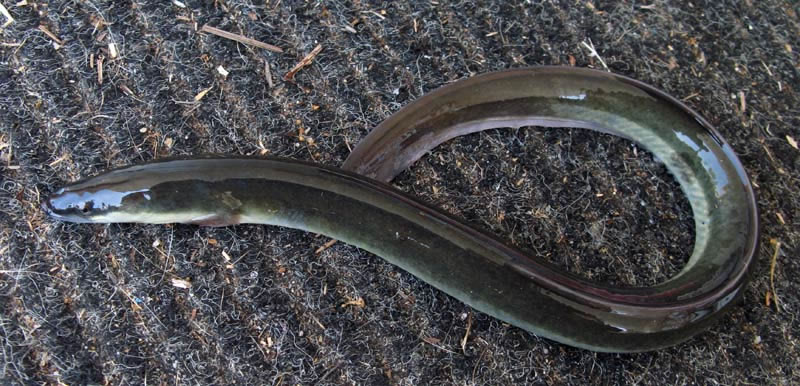Form Fits Function
The Anguilla rostrata’s form has a lot to
do with what stage of their life cycle they are in but it also has a depends
on the environment that these American eels are living. When they first
hatch the eels are small and thin juveniles called glass eels. This name is
fondly given to the larvae because they seem so translucent that the eel can
be considered to look like glass As the Anguilla rostrata grow
into the elver phase they become larger and start to form pigmentation (Oliveira). The third
phase is the yellow phase as shown in the picture on the right, which shows
a quite large eel for the yellow phase. The final phase the pigmentation is
complete and they turn a darker shade of brown depending on the surrounding
estuary bottom. The dark pigmentation on the dorsal side helps camouflage
them from predators. Especially attacks from the sky by eagle and other
birds that could spot them without this camouflage. This camouflage is
perfect for the murky estuaries and floor bottoms that the eel is accustomed
to in its development.
they become larger and start to form pigmentation (Oliveira). The third
phase is the yellow phase as shown in the picture on the right, which shows
a quite large eel for the yellow phase. The final phase the pigmentation is
complete and they turn a darker shade of brown depending on the surrounding
estuary bottom. The dark pigmentation on the dorsal side helps camouflage
them from predators. Especially attacks from the sky by eagle and other
birds that could spot them without this camouflage. This camouflage is
perfect for the murky estuaries and floor bottoms that the eel is accustomed
to in its development.
The long sleek body is great for getting into cracks and crevices for ambush attacks. Another form of the American eel is their beak shaped nose that is good at getting into small areas. The American eel can actually achieve fairly decent size as you see in the photo. Their form of movement is a side to side propulsion by is tail. This motion needs to be sustainable for the large migration back out in to the ocean from as far inland as Wisconsin and other Midwest states. This trip will take them a long time so the effortless back and forth motion of their tail is very important to not expend too much energy.
The Anguilla rostrata form fits its
function perfectly by blending in easily and living near the bottom of
estuaries to feed. It can be deduced that the Anguilla rostrata spend
most of their lives on the bottom of the estuaries from Ogden’s work on
their food habits showing that eels feed on crayfish and small slow moving
bottom feeders. mmersoni)
and the fallfish (Semotilus corporalis), that are small enough for
them to ingest.
mmersoni)
and the fallfish (Semotilus corporalis), that are small enough for
them to ingest.
To learn about the Reproduction and life history of the Anguilla rostrata click here